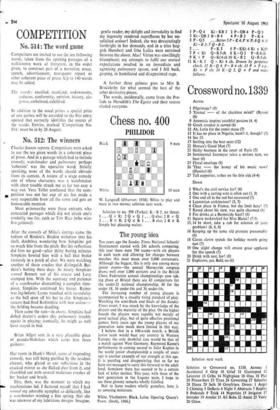Chess no. 400
PHILIDOR
Black White 9 men 10 men
W. Langstaff (Observer, 1938). White to play and mate in two moves; solution next week.
Solution to no. 399 (Turke): K – B 5, no threat.
1 Q x R; 2 Q x Q. 1 Q else; 2 R x Q. 1 . . . B X B; 2Q X B. 1 . . . B else; 2 B x B. Simple but pleasing waiter.
The young idea
Ten years ago the Sunday Times National Schools' Tournament started with 241 schools competing; this year there were 790 teams—with six players in each team and allowing for changes between matches this must mean over 5,000 contestants. Although the biggest, this is only one among many junior events—the annual Merseyside congress draws well over 1,000 entrants and in the British Chess Federation annual championships now tak- ing place at Bristol there are 43 competitors for the under-21 national championship, 48 for the under 18, 36 under-16s and 36 under-14s.
The increasing number of young players is accompanied by a steadily rising standard of play. Watching the semi-finals and finals of the Sunday Times event, I was struck by the knowledge of the players and the maturity of the play. On the higher boards the players were capable not merely of good tactical play, but of quite effective positional games; forty years ago the young players of my generation were much more limited in this way.
I believe that in a 100-a-side match, a British junior team would beat any country in Western Europe; the only doubtful case would be that of a match against West Germany. Raymond Keene's performance in coming second to Julio Kaplan in the world junior championship a couple of years ago is another example of our strength at this age. It is puzzling and disappointing that so far we have not managed to carry this forward to the adult level. Somehow there has seemed to be a certain lack of killer instinct. This year, with three of the new generation in the Lugano team, I hope to see these gloomy remarks wholly falsified.
Not to leave readers wholly gameless, here is an amusing miniature.
White, Vladimirov. Black, Leine. Opening, Queen's Pawn. (Sochi, 1966.)
1 P – Q 4 Kt–KB 3 2 P – QB 4 P – Q 3
3 Kt–QB 3 B–B4 4 P–B 3 P–K 4
5 P–QS ...Better 5P–K4,PXP;6QXP Kt –B 3; 7 Q–B 2.
5 . . . P –K 5 6 P – KKt 4 Kt x KtP.
7 P x Kt Q–RSch 8 K–Q 2 P–K6ch
9 K x P Q–Kt4ch 10 K–B 2 Q–R5ch
11 K –K 3 Q – Kt 4 ch. Drawn by perpetual check. 12 K–Q 4, P– B 4 ch; 13 P x P e.p., Kt x P ch; 14 K–Q 5, Q x P and mate follows.


































 Previous page
Previous page